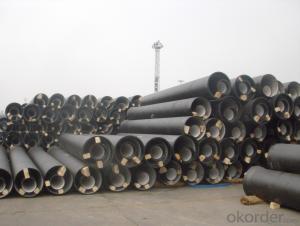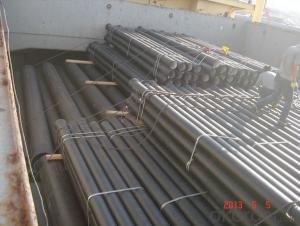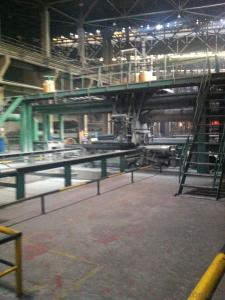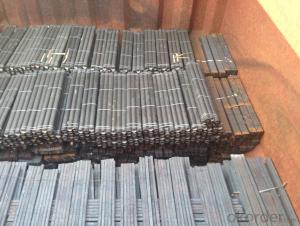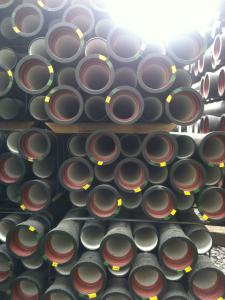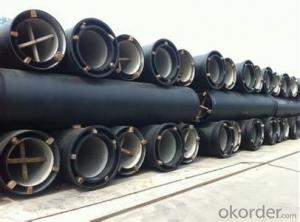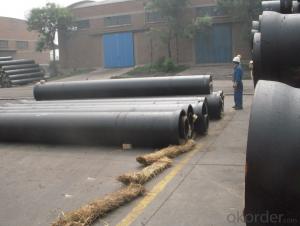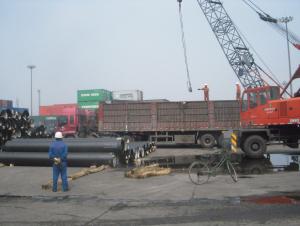DUCTILE IRON PIPES AND PIPE FITTINGS K8 CLASS DN500
- Loading Port:
- Tianjin
- Payment Terms:
- TT OR LC
- Min Order Qty:
- 22 pc
- Supply Capability:
- 3000 pc/month
OKorder Service Pledge
OKorder Financial Service
You Might Also Like
Material : Ductile Cast Iron
Size Range : DN 80mm to DN 2000mm
Unit Effective Length : 6m or 5.7m
Manufacture Standard: ISO 2531:1998/ EN 545:2006/EN 598:2007
Annual capacity : 200,000 tons
Coating Exterior: Zinc 130g/m2 according to ISO 8179-1 and bitumen coating 70 microns.
Cement Interior: Portland Cement/ High Alumina Cement/ Sulphate Resisting Cement Lining according to ISO 4179
Special requirements on external coating and internal lining can be applied
We also provide accessories such as SBR/EPDM rubber gaskets, lubricant paste, pipe caps, PE sleeves, etc.
Additional Parts:
Each pipe is strictly inspected according to related standard to ensure permanently high performance.
Easy Installation at site and service free for life
Long Service Lifespan
Quotation will arrive you within 24hours once we get your inquiry.
We guarantee offering you a competitive price.
A copy of original inspection reports of pipes will be offered after shipment.
Photos of loading process will be sent to the customer after shipment effect.
We will follow-up the delivery progress after shipment effect and update to the customer on weekly basis.
- Q: Can ductile iron pipes be used for bridge drainage systems?
- Yes, ductile iron pipes can be used for bridge drainage systems. Ductile iron is a strong and durable material that is commonly used in various applications, including water and sewage systems. It has excellent corrosion resistance and can withstand heavy loads and pressure, making it ideal for bridge drainage systems. Additionally, ductile iron pipes have a smooth inner surface that allows for efficient water flow, preventing clogs and blockages. Therefore, ductile iron pipes are a suitable choice for bridge drainage systems due to their strength, durability, and ability to handle the required water flow.
- Q: Are ductile iron pipes resistant to seismic events?
- Yes, ductile iron pipes are generally resistant to seismic events. Ductile iron is a type of cast iron that is known for its high strength and durability. It has the ability to withstand significant external forces, including those caused by seismic events such as earthquakes. Ductile iron pipes are designed to be flexible and can absorb and dissipate the energy generated by seismic waves. This flexibility allows the pipes to withstand ground movements and vibrations without breaking or cracking. Additionally, the joints of ductile iron pipes are designed to provide some degree of flexibility, which further enhances their resilience against seismic events. Moreover, ductile iron pipes are constructed with thick walls, providing them with a high level of structural integrity. This strength makes them less susceptible to damage during seismic events and helps maintain the flow of water and other fluids even under extreme conditions. However, it is important to note that the resistance of ductile iron pipes to seismic events can also depend on various factors such as the magnitude and proximity of the earthquake, the quality of installation and maintenance, and the specific design considerations for the pipeline system. Therefore, it is crucial to ensure that proper engineering and construction practices are followed to maximize the resilience of ductile iron pipes in seismic-prone areas.
- Q: Can ductile iron pipes be used for underground utilities?
- Yes, ductile iron pipes can be used for underground utilities. Ductile iron pipes are known for their durability, strength, and resistance to external pressure. This makes them a suitable choice for underground applications where the pipes need to withstand heavy loads, such as those found in utility installations. Ductile iron pipes are also resistant to corrosion, which is important for underground environments where the pipes are exposed to moisture and soil conditions. Additionally, these pipes have a longer service life compared to other materials, reducing the need for frequent replacements and maintenance. Therefore, ductile iron pipes are commonly used for underground utilities such as water distribution, sewage systems, and gas pipelines.
- Q: How do ductile iron pipes handle soil erosion?
- Ductile iron pipes are known for their exceptional strength and durability, making them highly resistant to soil erosion. The material used in ductile iron pipes is specifically engineered to withstand the effects of soil erosion, ensuring a long-lasting and reliable infrastructure. The composition of ductile iron pipes includes a mix of iron, carbon, and other alloying elements, which provides the necessary strength and resilience to withstand the forces exerted by soil erosion. These pipes have a higher tensile strength than traditional cast iron pipes, allowing them to resist deformation and cracking under pressure. Furthermore, ductile iron pipes have a protective layer called cement mortar lining, which acts as a barrier between the pipe and the surrounding soil. This lining provides an additional layer of resistance against corrosion and erosion caused by the soil's chemical composition or abrasive particles. As a result, ductile iron pipes remain intact and continue to function effectively even in areas with high soil erosion rates. In terms of installation, ductile iron pipes are designed to be buried underground, ensuring that they are well-protected from direct contact with the soil. Additionally, their jointing systems are designed to provide a secure and watertight connection, minimizing the risk of soil infiltration and subsequent erosion. Overall, ductile iron pipes have a proven track record of effectively handling soil erosion due to their superior strength, protective linings, and appropriate installation techniques. They offer a reliable and long-lasting solution for water and wastewater infrastructure, even in areas prone to soil erosion.
- Q: How are ductile iron pipes made?
- The manufacturing of ductile iron pipes involves a specific process called centrifugal casting. In this process, molten iron is poured into a rotating mold, typically made of steel. The rotation of the mold creates centrifugal force, which evenly distributes the molten iron, resulting in high-quality pipes. To start the manufacturing process, a mixture of scrap iron, steel, and recycled material is melted at extremely high temperatures in a furnace. Once the molten iron reaches the desired temperature and consistency, it is ready to be cast into pipes. To prevent the molten iron from cooling too quickly, the rotating mold is preheated. This preheating also contributes to achieving a smooth surface finish on the pipes. The molten iron is then poured into the rotating mold through a central sprue. As the mold spins, centrifugal force forces the molten iron against the inner walls of the mold. This rapid solidification results in dense, strong, and corrosion-resistant pipes. The centrifugal force also helps remove impurities or slag from the inner surface of the pipe, further enhancing its quality. Once the casting process is complete, the mold is allowed to cool, and the pipe is removed. The pipes undergo various tests to ensure they meet the required quality standards. These tests include checking dimensions, mechanical properties, and surface finish. After passing the quality tests, ductile iron pipes are typically coated with a protective lining to prevent corrosion and extend their lifespan. The type of lining used, such as cement mortar, epoxy, or polyethylene, depends on the intended application of the pipes. In conclusion, the centrifugal casting process is utilized to manufacture ductile iron pipes. This process ensures the production of high-quality pipes that are strong, corrosion-resistant, and have a smooth surface finish.
- Q: How does ductile iron pipe compare to steel pipe in terms of durability?
- Ductile iron pipe and steel pipe both have their own unique characteristics, but in terms of durability, ductile iron pipe has several advantages over steel pipe. Firstly, ductile iron pipe is highly resistant to corrosion. It has a protective layer of zinc or cement lining that prevents rust and corrosion, making it more durable and less prone to leaks or failures. On the other hand, steel pipe is susceptible to corrosion, especially when exposed to moisture or certain chemicals. This can lead to structural issues and decrease its overall durability. Secondly, ductile iron pipe has excellent impact resistance. It can withstand heavy loads and external pressures without cracking or breaking. This makes it suitable for applications in areas with high traffic or where the pipe may be subject to accidental impacts. Steel pipe, although strong, can be more brittle and prone to fractures under similar conditions. Additionally, ductile iron pipe has a longer service life compared to steel pipe. It has been known to last for over 100 years with proper maintenance, making it a reliable and durable choice for infrastructure projects. Steel pipe, while still durable, may require more frequent inspections and maintenance to ensure its longevity. Overall, ductile iron pipe surpasses steel pipe in terms of durability due to its corrosion resistance, impact resistance, and longer service life. However, the choice between the two ultimately depends on the specific application, budget, and other project requirements.
- Q: What is the expected maintenance for ductile iron pipes?
- The expected maintenance for ductile iron pipes typically includes regular inspections for signs of corrosion or damage, cleaning to remove any sediment or debris buildup, and occasional repair or replacement of sections that are worn or compromised.
- Q: Can ductile iron pipes be used in earthquake-prone areas?
- Yes, ductile iron pipes can be used in earthquake-prone areas. Ductile iron is a flexible and durable material that can withstand seismic activity and ground movements. It has been tested and proven to have high resistance against earthquakes, making it a suitable choice for infrastructure in earthquake-prone regions.
- Q: How are ductile iron pipes protected during transportation and storage?
- Ductile iron pipes are protected during transportation and storage through various methods to ensure their integrity and prevent any potential damage. Firstly, these pipes are typically coated with a protective layer, such as epoxy or zinc, which acts as a barrier against corrosion. This coating helps to safeguard the pipes from moisture and other corrosive elements during transit and storage. Additionally, ductile iron pipes are often bundled together and secured with straps or bands to prevent any movement or shifting that could lead to mechanical damage. This bundling also makes it easier to handle and transport the pipes in a more organized manner. During transportation, the pipes are usually loaded onto pallets or placed in crates to provide added protection and stability. This helps to minimize the risk of any accidental impact or rough handling that could potentially cause cracks or fractures. Furthermore, proper labeling and marking of the pipes is essential to ensure that they are handled appropriately. This includes displaying handling instructions, weight limits, and pipe specifications, which helps prevent mishandling and damage during transportation. Moreover, storage conditions are crucial to maintaining the integrity of ductile iron pipes. They should be stored in a clean, dry, and well-ventilated area to prevent exposure to moisture and humidity. Pipes should be kept away from direct sunlight and extreme temperatures to avoid any potential degradation of the protective coating. In conclusion, protecting ductile iron pipes during transportation and storage involves applying protective coatings, bundling and securing them, utilizing appropriate packaging materials, ensuring proper handling and labeling, and storing them in suitable conditions. These measures aim to maintain the quality and structural integrity of the pipes, ensuring they arrive at their destination in optimal condition.
- Q: What kind of joints are used with ductile iron pipe?
- Mechanical joints or push-on joints are commonly utilized with ductile iron pipe. Mechanical joints involve a gland and a rubber gasket for connecting pipes. These joints are fastened using bolts or other mechanical methods to ensure a secure and tight connection. On the contrary, push-on joints do not demand bolts or extra hardware. They only require the insertion of a rubber gasket into the socket of the pipe, resulting in a sealed connection. Both types of joints are extensively employed with ductile iron pipe, providing dependable and leak-proof connections for diverse applications.
Send your message to us
DUCTILE IRON PIPES AND PIPE FITTINGS K8 CLASS DN500
- Loading Port:
- Tianjin
- Payment Terms:
- TT OR LC
- Min Order Qty:
- 22 pc
- Supply Capability:
- 3000 pc/month
OKorder Service Pledge
OKorder Financial Service
Similar products
Hot products
Hot Searches
Related keywords
